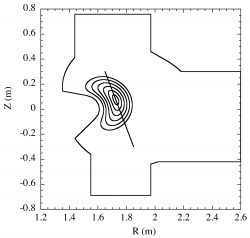TJ-II:Interferometry: Difference between revisions
| Line 3: | Line 3: | ||
== The Microwave interferometer == | == The Microwave interferometer == | ||
[[File:inter.png|250px|thumb|right|Diagram showing the geometry of the microwave interferometer at TJ-II]] | |||
The diagnostic is located in [[TJ-II:Sectors|sector]] B8. | The diagnostic is located in [[TJ-II:Sectors|sector]] B8. | ||
The probing beam has an inclination of 18.7° with respect to the vertical and a frequency of 140 GHz, corresponding to a wavelength of λ = 2.14 mm. | The probing beam has an inclination of 18.7° with respect to the vertical and a frequency of 140 GHz, corresponding to a wavelength of λ = 2.14 mm. | ||
Revision as of 12:33, 19 August 2010
TJ-II has two interferometry systems for the measurement of the line-integrated density.
The Microwave interferometer
The diagnostic is located in sector B8. The probing beam has an inclination of 18.7° with respect to the vertical and a frequency of 140 GHz, corresponding to a wavelength of λ = 2.14 mm. The line-integrated electron density is deduced from the cumulative phase change of the probing beam and the theoretical length of the intersection of the probing beam with the plasma (obtained from the magnetic geometry in vacuum).
Data description
The diagnostic delivers a time trace of the line-integrated electron density (65536 points, sampling rate 100 kHz). In the TJ-II database, the raw data are called 'INTERI', 'INTERQ', and the processed data 'Densidad2_'. The signal is less reliable for high densities (above 2-3 1019 m-3) due to the cumulative effect of spurious phase jumps. This time trace is fundamental for machine operation.
Two-colour interferometer
The double wavelength heterodyne interferometer (CO2: 10.6 μm, NdYAG: 1.064 μm) provides values of the plasma line integral density in scenarios with average densities ranging from a few times 1018 m–3 to more than 5×1019 m–3. The results have been compared with those from the 2 mm (microwave) interferometer, obtaining an excellent agreement. Working with a final bandwidth of 4 kHz, a one pass line integral error level about ±2×1017 m–2 has been achieved. [1] [2] [3] [4] [5] [6] The system is located in sector B1.
References
- ↑ H. Lamela et al, Laser interferometric experiments for the TJ-II stellarator electron-density measurements, Rev. Sci. Instrum. 72 (2001) 96
- ↑ M. Sánchez at al, High resolution CO2 interferometry on the TJ-II stellarator by using an ADC-based phase meter, Rev. Sci. Instrum. 75 (2004) 3414
- ↑ P. Acedo et al, CO2 (λm = 10.6 μm) He–Ne (λc = 633 nm) two-color laser interferometry for low and medium electron density measurements in the TJ-II Stellarator, Rev. Sci. Instrum. 75, 11 (2004) 4671
- ↑ M. Sánchez et al, Admissible Crosstalk Limits in a Two Colour Interferometers for Plasma Density Diagnostics. A Reduction Algorithm, PLASMA 2007, AIP Conf. Proc. 993 (2008) 187-190
- ↑ P. Acedo et al, Calibration of a high spatial resolution laser two-color heterodyne interferometer for density profile measurements in the TJ-II stellarator, Rev. Sci. Instrum. 79 (2008) 10E713
- ↑ L. Esteban, M. Sánchez, J.A. López, O. Nieto-Taladriz and J. Sánchez, Continuous plasma density measurement in TJ-II infrared interferometer—Advanced signal processing based on FPGAs, Fus. Eng. Design (2010) in press
